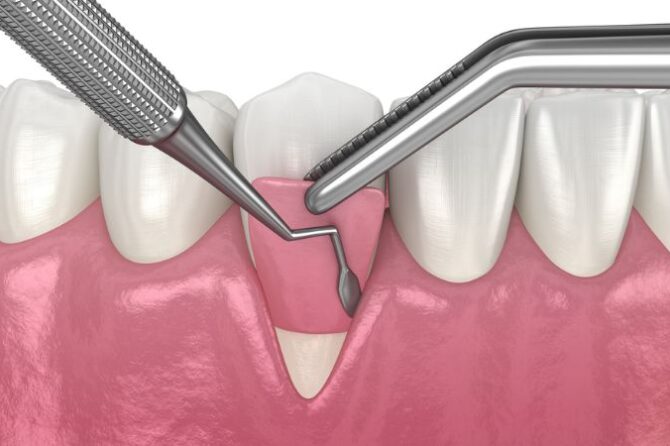
A Comprehensive Guide to Treating Receding Gums and can Receding Gums Grow back
Receding gums, also known as gum recession, is a common dental condition. It’s characterized by the shrinking of the gum line and may be caused by a range of factors including genetics, brushing too hard, or gum disease. In extreme cases, it can cause teeth mobility and tooth loss. The good news is that, in most cases, receding gums can be treated. But first, what exactly is gum recession and what causes it? Gum recession is a gradual process in which the gum tissue around the teeth gradually wears away, exposing the root. This process can cause teeth to become loose and eventually lead to tooth loss. Common causes of gum recession include poor dental hygiene, smoking, certain medications, and the natural aging process. Other causes may include aggressive tooth brushing, hormonal changes, diabetes, genetics, and gum disease (periodontal disease). Treating receding gums early on is crucial for avoiding serious dental issues down the road. Fortunately, there are a range of conventional treatments and home remedies available to slow the progression of gum recession and restore the gum line. In this guide, we’ll cover the various treatment options, the costs and insurance considerations, plus nutrition and oral health tips for preventing gum recession.
Treatment Options for Receding Gums
When it comes to treating receding gums, there are a few conventional treatments that may be used. These treatments may help to restore gum health and reduce further damage.
Antibiotics
Prescription antibiotics can be effective in treating gum disease, which is a major cause of receding gums. Antibiotics may be prescribed by a dentist or periodontist in the form of pills or rinses.
Bone Grafts
Bone grafting is a surgical procedure performed by a periodontist, which involves using donor tissue or synthetic material to build up the lost bone. This procedure can help to restore the natural structure of the gums.
Gum Surgery
Gum surgery is a type of gum treatment that is reserved for more severe cases of gum recession. The surgery is usually done by a periodontist and involves removing and reshaping the gum tissue in order to cover more of the exposed teeth.
Who Can Benefit from Treatment?
Treating gum recession can be beneficial for anyone who has experienced significant gum loss. However, it may be particularly helpful for people with severe gum disease or genetic factors that make them prone to receding gums. It is important to consult a dental professional before beginning any treatment for receding gums. They will be able to evaluate your situation and advise you on the best course of treatment for you. When it comes to treating receding gums, there are a variety of natural home remedies, lifestyle changes, and over-the-counter products that may help. While these treatments can often prove effective, it’s important to understand the potential risks associated with each option before beginning your treatment plan. Lifestyle Changes: Making changes in your lifestyle can often help reduce or slow down receding gums in a significant way. For example, cutting back on the consumption of sugary foods and drinks can help minimize the amount of plaque buildup on your teeth and gums and reduce your risk of gum disease. Additionally, quitting smoking and reducing your consumption of alcohol can also help to prevent gum recession. Home Remedies: There are some simple home remedies that may help to treat receding gums. For instance, rinsing your mouth with warm salt water can help to reduce inflammation and kill bacteria in your mouth. Applying clove oil directly to the gums can also help reduce inflammation and irritation. You should also consider using a soft-bristled toothbrush when brushing your teeth to avoid irritating your gums. Over-the-Counter Products: There are many over-the-counter products available that may help to treat receding gums. Mouthwashes containing fluoride can help to strengthen your enamel and reduce plaque buildup. You should also look for toothpastes that contain fluoride, as this can help to protect your gums from receding further. Additionally, there are a variety of Vitamin C supplements available that may help to strengthen your gums. It is important to remember that natural home remedies and over-the-counter products may not always be enough to treat receding gums in more severe cases. If you find that your receding gums are still persisting, make sure to speak to your dentist about other treatment options. Gum grafting and surgery can be used to correct the effects of receding gums. In some cases, this may even help gums grow back to their original state. The procedure is not for everyone, but it is a viable option for those who have severe gum recession or other dental issues that may cause gum recession. Before deciding if gum grafting and surgery are right for you, it is important to understand the qualifications necessary for this type of procedure. First and foremost, you must be healthy enough to undergo surgery. If you have any medical problems or conditions, you should discuss them with your dentist or oral surgeon prior to the procedure. In addition to being in good health, you should have sufficient bone in your jawbone to support the surgery. Your dentist will evaluate your bone density to determine if you are a suitable candidate. If they find that you do not have enough bone, they may refer you to an oral surgeon who can perform a bone graft to correct the problem. Once you have been deemed a suitable candidate, your dentist or oral surgeon will explain the details of the procedure and recovery process. The procedure itself typically takes between one and two hours, depending on how extensive the work needs to be. Afterwards, you will be given instructions on how to care for your gums during the healing process. This usually includes eating soft foods, avoiding strenuous activities, and practicing good oral hygiene. You may also be provided with pain medication to help manage any discomfort you may experience. The recovery period for a gum grafting or surgery procedure can vary, but it typically takes about three to four weeks for the gums to heal completely. During this time, you should avoid brushing too hard or flossing in the area of the surgery. Additionally, you should keep an eye out for any signs of infection or other complications. If you have any concerns, you should contact your dentist or oral surgeon as soon as possible. Gum grafting and surgery are effective treatments for receding gums, but they are not without risks. It is important that you discuss the procedure and associated risks with your dentist or oral surgeon before making any decisions. With the right information and your dentist’s guidance, you can make the best decision for your oral health. Gum grafting and surgery can be an expensive treatment for receding gums, with prices ranging anywhere from several hundred to thousands of dollars. Insurance may be able to cover some or all of the costs depending on the policy and what type of procedure is necessary. It’s important to check with your insurance provider to find out what specific coverage you have. If you don’t have insurance, there are still options available to help you pay for gum grafting or surgery. Some dentists offer financing plans that can help spread the cost out over time. You may also be able to get a loan from your bank or look into credit cards with interest-free payment plans. It’s also important to note that not all procedures will be covered by insurance, so you should make sure you understand your policy’s terms and restrictions before undergoing any treatment. Additionally, you should ask your dentist for an estimate of the total cost of the procedure before you agree to it. That way, you can plan ahead and make sure you have enough money saved up before you start the treatment process. Most importantly, find out if the costs associated with treating your receding gums are covered by your insurance policy. If so, you should be sure to take advantage of the coverage, as having insurance could save you hundreds or even thousands of dollars in the long run. Good oral health is essential to halting and reversing gum recession. Eating a balanced diet with plenty of vitamin C and other essential nutrients can help keep your gums and teeth healthy, while avoiding foods that are high in sugar or acid can reduce the risk of gum disease. Additionally, brushing your teeth twice a day and flossing daily are critical to keeping your teeth and gums healthy. It’s also important to take care of your teeth and gums during activities like eating and drinking. When eating, avoid chewing on hard objects such as ice, candy, or pens; this can cause gum damage. Similarly, try to avoid consuming acidic beverages like soda, as this can erode tooth enamel and increase your risk of gum disease. Finally, regular visits to your dentist are a must. Not only will they be able to advise you on how to best care for your teeth and gums, they can also diagnose any issues quickly and begin an appropriate treatment. If you begin to experience signs of gum recession, make sure to consult your dentist right away. It’s important to take gum recession seriously as it can lead to tooth decay, gum disease, and even tooth loss. The key to treating receding gums is identifying the underlying cause, whether it’s genetics, poor oral hygiene, brushing too hard, or gum disease, and then taking the necessary measures to treat it properly. Conventional treatments include antibiotics, bone grafts, gum surgery, and others. There are also natural home remedies and over-the-counter products that may be used for the treatment of receding gums. Gum grafting and surgery are also possible but insurance may cover the cost depending on the severity of the receding gums. Nutrition and proper oral hygiene are essential for preventing and reducing gum recession. Eating a balanced diet, brushing twice a day with an electric toothbrush, flossing or using interdental cleaners, and avoiding smoking and sugary foods are all good habits to develop. In conclusion, receding gums are a serious issue that should be addressed as soon as possible. Understand your risk factors, choose the right treatment option based on the underlying cause, and follow healthy nutrition and oral hygiene habits to lessen or eliminate gum recession.

FAQs About Receding Gums and Treatment Options
There are many questions people may have when it comes to receding gums and treatment options. Here, we answer some of the most commonly asked questions about receding gums.
Can receding gums grow back?
The answer to this question is that, in some cases, it is possible for receding gums to grow back. It all depends on what caused the receding in the first place. For example, if the cause was poor oral hygiene or brushing too hard, then receding gums can often grow back if proper care is taken to improve the health of the gums. However, if the cause was something like gum disease or genetics, then it is likely that the receding gums will not grow back on their own.
What are the treatments available for receding gums?
The treatments available for receding gums depend on the cause of the receding. In some cases, conventional treatments such as antibiotics, bone grafts, and gum surgery can be used to restore the gums. For those who prefer natural home remedies, there are lifestyle changes and over-the-counter products that may help.
How much does gum grafting or surgery cost?
The cost of gum grafting or surgery typically varies based on the severity of the symptoms and the extent of the procedure. Depending on your insurance plan, you may be able to have some form of coverage for these treatments. There are also financing options available from some medical providers.
What preventive measures can I take to stop my gums from receding?
In order to prevent receding gums, it is important to practice good oral hygiene and maintain a healthy diet. Brushing twice daily with a soft-bristled toothbrush, flossing regularly, and using an antiseptic mouthwash can all help to keep your gums healthy. Eating a balanced diet with plenty of vitamins and minerals is also beneficial for maintaining healthy gums. Receding gums can be a cause for concern, as it can ultimately lead to tooth loss. A shareable infographic is a great way to share information about the causes and treatments of receding gums, as well as helpful tips for owners of receding gums. The infographic should provide an overview of what causes receding gums, such as genetics, poor dental hygiene, gum disease, and aggressive brushing. It should also include information on the various treatments available, such as antibiotics, gum grafts, surgery, and lifestyle changes. The infographic should also include helpful tips related to oral hygiene, such as brushing twice daily, flossing every day, and visiting the dentist regularly. It should also list the signs of gum recession and advice on when to seek professional medical advice. Having a shareable infographic allows people to quickly access important information about receding gums in a visually appealing format. It encourages users to share this information, thus increasing the spread of knowledge and awareness about the condition and its treatment options. More information about receding gums can be found through multiple sources. In this section, we will include some of the best further reading resources available so that you can continue to learn and make informed decisions. For an overview of receding gums, including potential causes and treatments, check out this article from the American Dental Association: https://www.mouthhealthy.org/en/az-topics/r/receding-gums The Mayo Clinic also has a great article on receding gums: https://www.mayoclinic.org/diseases-conditions/receding-gums/symptoms-causes/syc-20376893 For information specific to gum grafts, this resource from the Academy of General Dentistry is helpful: https://www.agd.org/publications/patient-education/gum-graft Finally, for those interested in natural home remedies and lifestyle changes to promote oral health and help prevent receding gums, this article from Healthline is useful: https://www.healthline.com/health/healthy-teeth/home-remedies-for-receding-gums. By consulting these resources, you should feel more empowered to make the right decision regarding your oral health. Gum recession is a common dental issue and can have a variety of causes. In order to better understand receding gums and treatment options, it’s important to be familiar with the medical terms associated with this condition. Here is a glossary of some of the most commonly used terms related to receding gums:
Glossary of Terms
- Gingivitis: Inflammation of the gums caused by bacteria in plaque. It is the earliest stage of gum disease.
- Periodontal Disease: A serious infection of the gums caused by the buildup of plaque. Symptoms include bleeding, swollen, and tender gums.
- Scaling and Root Planing: A type of deep cleaning used to treat periodontal disease. It involves removing plaque and tartar deposits from below and above the gum line.
- Gum Grafts: Surgery to replace lost gum tissue with another tissue type. This helps reduce further gum recession and restore the natural contour of the gums.
- Pocket Reduction Surgery: Surgery to reduce the depth of periodontal pockets, where plaque builds up and causes infection.
- Bone Grafts: A procedure to repair bone loss or restore bone structure in cases of severe periodontal disease.
By understanding these terms and their definitions, you can better comprehend the various treatment options for receding gums. In conclusion, receding gums can be a frightening experience, but it is one that can be effectively addressed with the right treatment and prevention methods. While conventional treatments such as gum surgery and bone grafts are available, there are also natural and at-home remedies that may be helpful in preventing and/or treating receding gums. Eating a healthy diet, brushing and flossing in the correct way, and maintaining good oral hygiene can all help to prevent receding gums, while regular visits to the dentist should be made for diagnosis and monitoring. Ultimately, receding gums can be a manageable condition, and proper care can help to keep your gums healthy and strong.
FAQs About Receding Gums Treatment
- Q: What are the most common causes of receding gums?
A: The most common causes of receding gums include genetics, brushing too hard, and gum disease. - Q: What treatments are available for receding gums?
A: Common treatments for receding gums include prescription antibiotics, bone grafts, gum surgery and other more natural home remedies. - Q: How can I prevent gum recession?
A: Practicing proper oral hygiene and nutrition, such as brushing and flossing twice per day and avoiding sugary and acidic foods and beverages, can help prevent gum recession. - Q: What is gum grafting?
A: Gum grafting is a surgical procedure in which a strip of healthy tissue is extracted from the roof of the mouth and then used to cover the exposed tooth roots. It is often used to treat gum recession. - Q: How long does it take to recover after gum grafting?
A: Recovery time for gum grafting can range anywhere from one to two weeks. Depending on the complexity of the case, recovery may take longer. - Q: Does insurance cover gum grafting?
A: Depending on your insurance policy, some procedures may be covered by insurance. It is best to check with your insurance provider to find out. - Q: Can receding gums grow back?
A: In some cases, it is possible for receding gums to grow back naturally with proper treatment. However, this is not always the case, and in severe instances surgery may be required.
